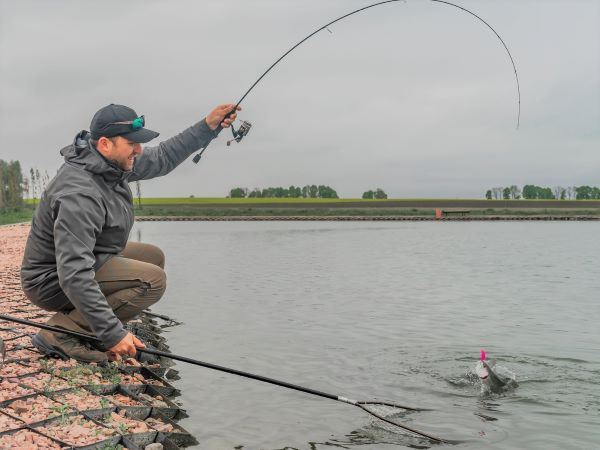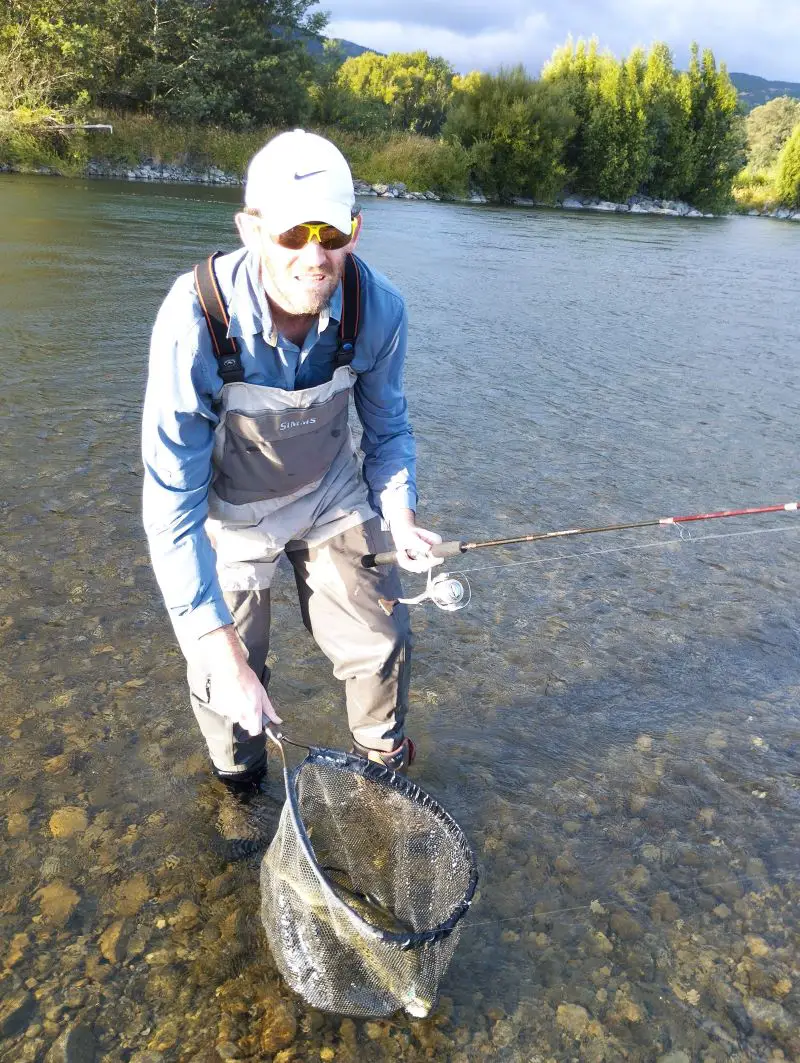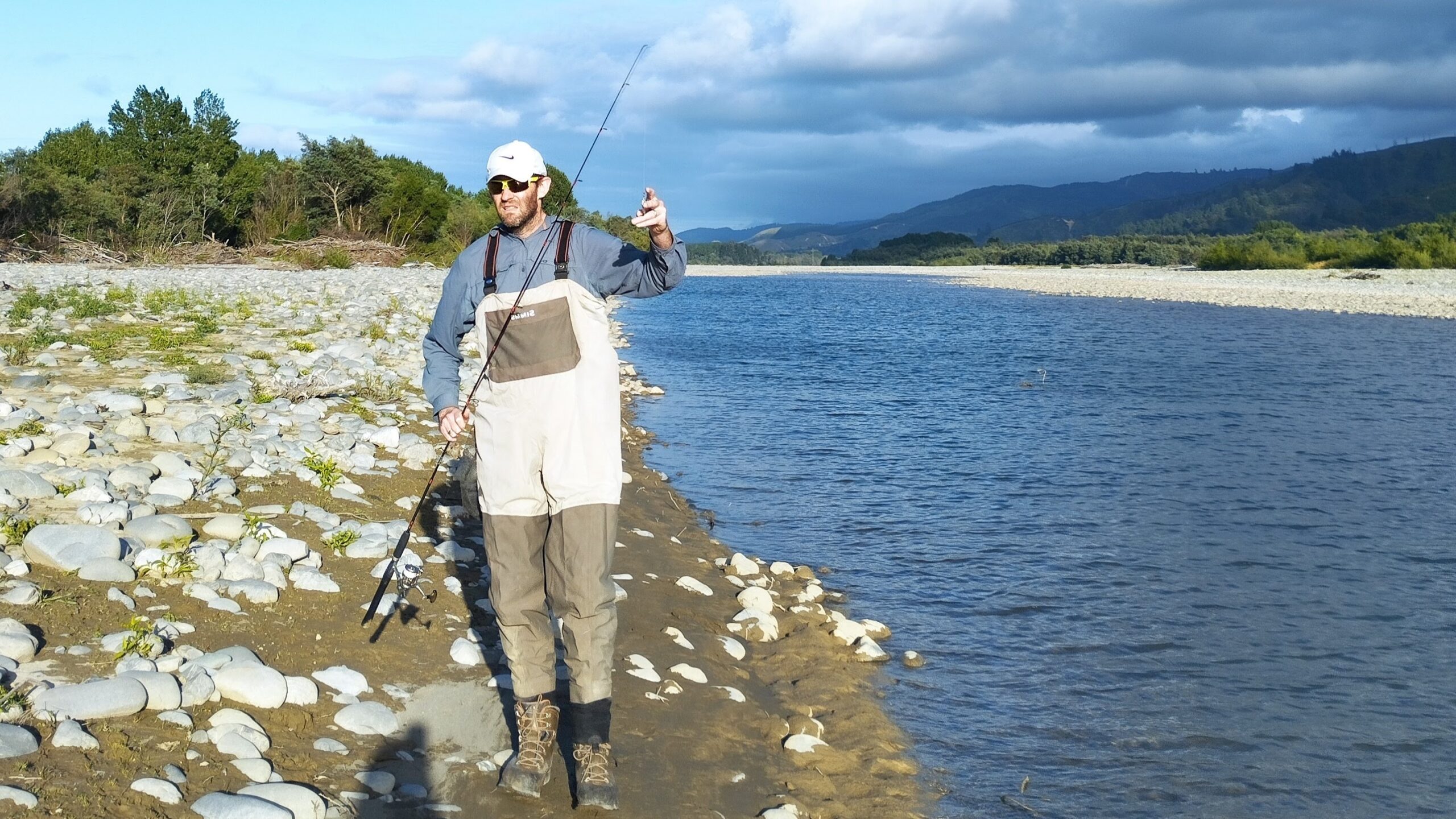A 6ft6″ – 7ft long spinning rod works best in most trout fishing situations. This is a good general-purpose length for fishing from either the shore or a boat. It is what I use for 90% of my trout fishing.
Some anglers prefer rods as short as 4ft6″ when fishing small overgrown streams where casting room is limited. While some lake or large river anglers use rods over 8ft.
The above are just generalizations, below I will explain in more detail the best length spinning rods for different types and styles of trout fishing.
I will discuss the factors to consider when choosing a rod depending on where you plan to use it (stream, river, lake) and how you plan on fishing it.
A rod that is best suited for a large open lake, is very different from a rod that is well suited for an overgrown creek or when casting from the cramped confines of a boat.

Advantages of longer spinning rods
Longer rods cast further, A longer rod, assuming it has comparable power and action will cast further than a shorter rod. This difference in distance is not that significant. I have spent many hours, standing on empty fields and beaches, comparing the casting distances of various rod combos, and when casting comparable rods, that only differ in length, at best the longer rod will give a few extra feet of distance.
Upgrading from a 6ft rod to a 7ft rod is not going to be a night and day difference in distance. Changing from a 4’6″ rod to an 8ft rod might be. If I have to give a figure, a 7’2″ rod will be lucky to cast 3-5% further than a 6ft rod.
You can easily surpass that distance by up to 10% by using the side cast technique rather than the more common overhead cast.
Longer rods offer improved line management, this extra length allows the user to impart more action and movement down the line to the lure. It can also make setting the hook easier if there is any slack in the line. If you minimize the amount of slack in your line, this extra control is a bit of a moot point.
Improved steering and control while fighting a fish. For example, if the fish swims beneath the hull, a longer rod has the length to lift the line over the outboard allowing you to fight the fish on the other side. A shorter rod typically means fighting the fish from under the boat. It can be done, but it might increase the risk of breaking off.
Fights are more fun. Many fishermen find fighting fish on longer rods more exciting. That is because a longer rod gives the fish more leverage making it seem bigger and the fight harder. This is also the reason why all big game rods are very short. It gives the leverage advantage to the fisherman.
Advantages of shorter spinning rods
Better weight-to-power ratio. They are lighter and less tiring to use. Okay, this might not sound like much of a problem, but believe me, I start to tire after a couple of hours swinging a 9ft fly rod back and forth, while I suffer no such fatigue when fishing with a 7ft spinning rod.
Easier to fish in cramped locations. Rods under 6’6″ in length are ideal for use in overgrown streams, they are also my personal choice when fishing from a kayak or canoe.
A short rod gives you more leverage over the fish. It makes the fight easier, this is not really a big factor when it comes to trout fishing but for completeness’ sake, I thought I should mention it.
Easier to cast accurately. Some fishermen also find shorter rods are easier to cast accurately. I personally find accuracy comes with familiarity with the combo more so than rod length.
More portable. A shorter rod is easier to transport and takes up less space in the car. In saying that, multiple-section rods do solve this problem.
Additional information regarding rod length
One point I want to mention, as a rod gets longer, the base section nearly always gets thicker. This is to maintain rigidity.
This means it requires a more powerful cast to fully load the blank. On some fast-action long rods, only the tip section is flexible enough to fully load, this means only the is responsible for the majority of momentum during the cast.
Such a rod, when not fully loaded might not actually cast further than a shorter rod that loads more evenly.
This is also the reason why competition casters rarely use rods longer than 13ft (and they use 3-4oz sinkers to load them, it will be hopeless trying to cast a trout spinner on such a rod.) So. there is an upper limit. Longer rods do exist, but they are used primarily when surf fishing and their purpose is to keep the line out of the swell.
How does rod material affect rod length choice?
Longer rods are nearly always made out of graphite, simply because it has such a good weight-to-strength ratio. As the blank building technology gets better, it has allowed rod designers to push the limits of what’s possible. This has resulted in longer rods, that are still lightweight and capable of casting lures weighing under an ounce. Such rods were nearly unheard of 20 years ago.
Shorter rods are commonly made out of one of three materials. These being graphite (or carbon), composite (which is a graphite-glass blend), and fiberglass.
Fiberglass rods are typically the shortest of the bunch, that is because fiberglass has quite a poor strength-to-weight ratio, and a long glass rod will be much too heavy for casting lightweight lures.
There are also some exotic materials like bamboo or boron. But no one really uses these in spinning rods anymore.

Best rod length for different styles of fishing
Which spinning rod length for shore fishing
When there is sufficient casting room you can get away with any length spinning rod. So when fishing from the beach or open rivers, a standard 6’6″’-8’ long rod would suit most fishing needs.
I personally prefer a 7ft rod when lake fishing, but will drop back to 6’6″ when river fishing.
I favor that length because it is a good compromise between cast speed, strength, and overall weight. This allows for long casts, with plenty of backbone to control the fight. It is also not too long to be cumbersome while netting fish.
If all you care about is inching out every little bit of extra distance, then certainly consider an 8ft or longer rod. Just keep in mind landing fish is going to be harder.
Which rod to buy when trout fishing?
If you just want a basic trout rod, suitable for various styles of fishing then a budget-friendly rod I am happy to recommend is the 6’6′ version of the Okuma Celilo (link to amazon).
If all you care about is maximizing casting distance then consider the 8’6′ version.
For its price, the Celilo is a very sensitive and lightweight rod. When paired with a lightweight and smooth reel it casts like a rocket. It is hard to get a better rod without spending significantly more money
Best trout spinning rod length for fishing overgrown streams
When fishing a lot of tight water around overgrown shorelines. A long rod is a hindrance, branches keep getting in the way preventing full-length casts.
In such situations, a short rod around 4’6″-5’5″ is ideal. A short rod is also easier to walk through thick vegetation with.
One downside, fishermen struggle to cast long distances with a short rod. If casting distance is still important, then a 5’5” or 6′ rod is a suitable compromise.
Which stream rod to buy?
For a tough, no-nonsense spinning rod that is affordable enough to treat rough then I recommend the Shakespeare Micro Spinning. It is a great rod for overgrown waters.
Best rod length for trolling?
Rods between 7-9ft are often suggested for a dedicated trolling rod.
The reason why long rods are recommended is that the length increases the spread between the lures behind the boat. So basically, the lures swim further apart preventing the chance of a tangle occurring.
For this reason, most trolling rods are between 7’6” to 8.
Now, a long rod is not required. Where I fish, I can only use a single rod at a time. So I use a standard length 6’6″ rod and have no issues. So unless you plan on fishing multiple lures at once long trolling rods are far from essential.
Best trout spinning rod length for canoe and kayak fishing?
There are two trains of thought regarding the optimal rod length for kayak fishing.
There are fans of long rods, but also equally vocal supporters of short rods.
Over the years, I have owned and fished both. Overall, I am more a fan of the shorter rods, but both lengths have advantages.
The fans of the long rods favor them because the length allows them to move the line around the bow of the boat. This allows fish to be fought on either side of the kayak. The downside of a long rod when kayak fishing is that netting the trout becomes difficult, and the length makes it a bit tricky when changing terminal tackle.
The supporters of the short rods (including myself) favor them because they are simply easier to fish with. The shorter length makes changing terminal tackle easier. Short rods are also easier to store inside hatches and are less likely to bump into overhead branches when paddling close to the shore.
Which kayak rod to buy?
My recommendation for a kayak fishing rod is the Shakespeare Micro Spinning Rod.
It is affordable, durable, and comes in a range of sizes. Kayak fishing is tough on equipment. This Shakespeare rod is cheap enough to abuse while being nice enough to use.
Best trout spinning rod length for children?
Children’s fishing rods are normally very short. Some are even under 4ft in length. Such a length makes them difficult to cast.
Children need shorter and lighter rods than adults but not to such extremes. I suggest a rod between 4’6″-5’5″ is good for a small child. Teenagers and taller children can fish with full-length rods.
There are some truly terrible rods marketed to children. So if budget allows, ignore the marketing and purchase a short fiberglass rod. Graphite rods are simply too fragile to survive how roughly some children treat their gear. For example, the Shakespeare Micro Spinning Rod offers great value for money and is a good first rod.
Follow this link for more information on buying a suitable fishing rod and reel for children.
Single or multiple-piece trout spinning rod?
One of the biggest downsides to fishing with long rods is that they can be difficult to transport. Luckily multi-piece rods exist and I see no downsides to owning one. I own single piece rods, I rarely fish them. They take up too much space in the trunk.
For ease of transport, I always suggest getting a 2-piece rod. Being able to split a rod in half and fold together makes transporting it in a car significantly easier. If you plan on purchasing a very long rod say 9ft then getting it in 3 or 4 sections can make transporting it more user-friendly.
A two section 6’6″ rod when split in half can easily be stored in the trunk of any car or even laid across the backseat. It can start becoming a bit more tricky to transport rods significantly longer than that.
Some people worry that the joins (or ferrule) in a multiple-piece rod are a potential weak spot. Bass on my own personal experience, ferrule technology is now so advanced that there is no significant difference in rod performance between a single-piece and multi-piece rod.
Conclusion
Above we discuss the most suitable trout spinning rod for different styles of fishing.
To summarize, when fishing in areas that have a lack of space consider a shorter rod. When fishing out in the opening a longer rod can allow for longer casts.
If you have any questions feel free to ask them below. If you are also in the market for reels, we suggest reading our guide on the best trout spinning reels.

